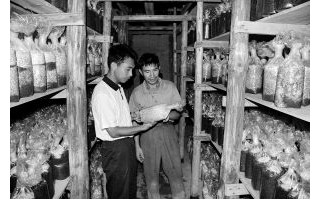松口蘑與假松口蘑ITS序列測定和分析比較
SEQUENCE ANALYSIS OF THE INTERNAL TRANSCRIBED SPACER OF GENE CODING FOR rRNA IN TRICHOLOMA MATSUTAKE AND TRICHOLOMA BAKAMATSUTAKE
沙濤 丁驊孫 李覓 張漢波 程立忠 趙之偉 張亞平
摘 要:對松口蘑和假松口蘑進行ITS序列測序,通過DNAStar軟件比較分析,發現松口蘑與假松口蘑的5.8S rDNA序列完全一致,ITS1和ITS2呈現不同程度的多態性.松口蘑ITS序列長度為601bp,假松口蘑ITS序列長度為563bp.設計了擴增松口蘑和假松口蘑ITS1的特異性引物,能夠快速地區別松口蘑與假松口蘑.
關鍵詞:多態性,序列長度,特異性引物
分類號:Q936 文獻標識碼:A
文章編號:1672-6472(2005)01-0048-0052
基金項目:"十五"國家科技攻關計劃"生物資源與生物安全技術研究開發"項目(批準號:No.2001BA707B01);中央級科研院所科技基礎性工作專項--重要野生食用真菌種質資源收集與保藏研究
作者單位:沙濤(云南大學生物資源保護與利用國家重點實驗室培育基地,昆明,650091)
丁驊孫(云南大學生物學系,昆明,650091)
李覓(云南大學生物學系,昆明,650091)
張漢波(云南大學生物資源保護與利用國家重點實驗室培育基地,昆明,650091;云南大學生物學系,昆明,650091)
程立忠(云南大學生物學系,昆明,650091)
趙之偉(云南大學生物資源保護與利用國家重點實驗室培育基地,昆明,650091)
張亞平(云南大學生物資源保護與利用國家重點實驗室培育基地,昆明,650091;中國科學院昆明動物研究所,昆明,650223)
參考文獻:
[1]Gong MQ, Wang FZ, Chen Y, Chen YL, Cao JX, Su LJ, 2000. Protecting the eco-environment of Tricholoma matsutake and improving its sustainable development. Forest Research, 13 (5):562~567 (in Chinese)
[2]Guerin-Laguette A, Matsushita N, Kikuchi K, Iwase K, Lapeyrie F, Suzuki K, 2000. Identification of a prevalent Tricholoma matsutake ribotype in Japan by rDNA IGS1 spacer characterization. Mycol Res, 106 (4): 435~443
[3]Kikuchi K, Matsushita N, Guerin-Laguette A, Ohta A, Suzuki K, 2000. Detection of Tricholoma matsutake by specific ITS primers. Mycol Res, 104 (12): 1427~1430
[4]Luo XC, 2001. DNA fingerprinting identification of isolates in mushrooms. Edible Fungi of China, 20 (3): 3~5 (in Chinese)
[5]Mao XL, 1998. Economic Fungi of China. Beijing: Science Press, 1~762
[6]Schmidt O, Moreth U, 2002. Data bank of rDNA-ITS sequences from building-rot fungi for their identification. Wood Science and Technology, 36: 429~433
[7]White TJ, Bruns TD, Lee SB, Taylor JW, 1990. Amplification and direct sequencing of fungal ribosomal RNA genes for phylogenetics. pp. 315~321 In PCR Protocols: A Guide to Methods and Applications, edited by Innis MA, Gelfand DH, Sninsky JJ, and White TJ. Academic Press, New York
[8]Wipe D, Munch J, Botton B, Buscot F, 1996. DNA polymorphism in morels: complete sequences of the internal transcribed spacer of genes coding for rRNA in Morchella esculenta (Yellow Morel) and Morchella conica (Black Morel). Applied and Environmental Microbiology, 62 (9): 3541~3543
[9]Yu FQ, Wang XH, Liu PG, 2002. Prospects of exploitation and utilization on edible fungus resource in Yunnan. Chinese Wild Plant Resources, 21 (4): 21~25 (in Chinese)
[10]Zeng DF, Luo XC, Fu WJ, 2001. Studies on the isolation, culture and DNA identification of mycelia of Tricholoma matsutake. Acta Mirobiologica Sinica, 41 (3): 278~284 (in Chinese)
[11]Zhao ZL, Xu LS, Dong H, Wang ZT, 2000. Evaluation of ITS sequence of nrDNA inpant molecular systematics. Journal of Plant Resources & Environment, 9 (2): 50~54 (in Chinese)
[12]于富強, 王向華, 劉培貴, 2002. 云南食用菌資源應用開發前景與展望. 中國野生植物資源, 21 (4): 21~25
[13]弓明欽, 王鳳珍, 陳羽, 陳應龍, 曹嘉相, 蘇聯軍, 2000. 保護松茸生態環境促進松茸可持續發展--關于恢復與發展云南松茸的探討. 林業科學研究, 13 (5 ): 562~567
[14]卯曉嵐, 1998. 中國經濟真菌. 北京:科學出版社, 1~762
[15]羅信昌, 2001. 蘑菇分離物的DNA指紋鑒別. 中國食用菌, 20 (3): 3~5
[16]趙志禮,徐珞珊,董輝, 王崢濤, 2000. 核糖體DNA ITS區序列在植物分子系統學研究中的價值. 植物資源與環境學報, 9 (2): 50~ 54
[17]曾東方, 羅信昌, 傅偉杰, 2001. 松茸菌絲體的分離和RAPD-PCR分析. 微生物學報, 41 (3): 278~284
菌物學報
MYCOSYSTEMA
2005 Vol.24 No.1 P.48-52






